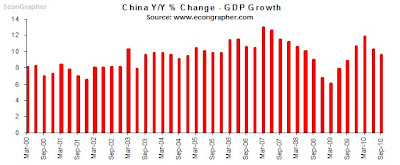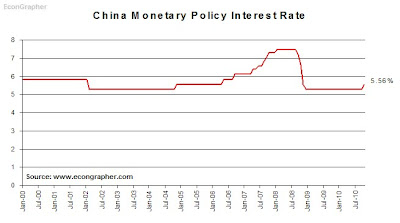This week the focus is on China, with the quarterly statistics out this week - as well as a surprise interest rate increase from the PBOC. Among the data we review in this edition is GDP growth, inflation trends, the interest rate decision, retail sales growth, and the continued rise of new lending.
1. China GDP
First up is GDP, China saw growth decelerate slightly to 9.6% year on year in the September quarter (or 10.6% YTD on YTD), down slightly vs the 10.3% growth rate in the June quarter. Some of the deceleration was due to a higher base comparison period, but also impacts from macroeconomic controls put in place by the government. So basically the Chinese economy is still tracking along at a relatively fast pace.

2. China Inflation Outlook
Of course the inflation outlook should also remain elevated. The September inflation figure was 3.6% vs 3.5% in August, and 2.9% in June. The PBOC Future Price Expectations Index was also recently released; rising to 73.2 from 70.3 as inflation expectations remain elevated. Much of the inflation result was driven by food prices. Overall the inflation outlook for China remains high, a simple convergence in the chart below should say that one or the other has to give soon (i.e. either higher inflation or lower expectations), but the fundamentals line up with rising inflation.

3. China Monetary Policy
So it's not a major surprise then that the PBOC raised interest rates, especially in the back drop of a series of increases in the Required Reserve Ratios for the banks. The People's Bank of China increased the main policy rate 25bps to 5.56% from 5.31%, as well as increasing the 1-year benchmark deposit rate 25bps to 2.50% from 2.25%, marking the first increase since 2007. The move is a logical response to the rapid growth in lending (more on that later), concerns about asset bubbles and overheating, as well as the usual monetary policy reason of higher inflation.

4. Retail Sales
The consumer spending data shows no tapering off either, with continued strong growth - a positive sign for an economy that is facing the challenge of rebalancing to a domestic demand vs export driven growth. The fastest growing categories were 'Gold and Silver Jewelry' (54.9%), 'Furniture' (39.6%), and 'Building and Decoration Materials' (39%), while the largest categories were 'Automobile' (CNY 148 bn), 'Petroleum and Related Products' (CNY 93.7bn), and 'Grain, Oil, Foodstuff, Beverages, Tobacco, and Liquor' (CNY 70.2 bn). So what does that tell us? Chinese consumers are spending most of their money on cars and driving, and spending on discretionary wealth or status items is rising fast. Which is not overly surprising given the per capita rise in income of 9.7% (driven by an 18.7% increase in income from wages and salaries).

5. New lending
The value of new loans is consistently rising in China, attracting the attention and action from the central bank. And wisely so, as the rapid pace of growth in loans threatens to blow out inflation, and potentially create overheating and asset bubble issues. But cultural and regulatory factors have dictated a relatively lower use of debt (as compared to e.g. the US). So lending growth may well be key factor in rebalancing China's economy - the key is getting it done sustainably, and avoiding the excesses demonstrated by the US experience.

Summary
So the Chinese economy is still going strong, judging by the data that was released this week. This is heartening given the slowing that we're seeing in several other key economies e.g. US, Japan... but at the same time the divergence in economic prospects has created tensions.
For China the outlook appears to be for continued strong growth, rising inflation; and accordingly tighter monetary policy conditions (which is good for the sustainability of the economic growth). There are promising signs on the rebalancing process in the consumer spending data (though more needs to be done), but also interesting signs around wealth and income levels.
The key risks for China's economy remain; inflation and overheating, potential impact from the global economic slowdown, the challenges in reorientating the economy to a domestic demand led strategy from an export led strategy, and policy risk (i.e. tightening too much too fast). Apart from that expect more of the same.
Sources:
1. National Bureau of Statistics www.stats.gov.cn
2. National Bureau of Statistics www.stats.gov.cn & People's Bank of China www.pbc.gov.cn
3. People's Bank of China www.pbc.gov.cn
4. National Bureau of Statistics www.stats.gov.cn
5. People's Bank of China www.pbc.gov.cn
Article Source: http://www.econgrapher.com/top5graphs23oct.html
1. China GDP
First up is GDP, China saw growth decelerate slightly to 9.6% year on year in the September quarter (or 10.6% YTD on YTD), down slightly vs the 10.3% growth rate in the June quarter. Some of the deceleration was due to a higher base comparison period, but also impacts from macroeconomic controls put in place by the government. So basically the Chinese economy is still tracking along at a relatively fast pace.

2. China Inflation Outlook
Of course the inflation outlook should also remain elevated. The September inflation figure was 3.6% vs 3.5% in August, and 2.9% in June. The PBOC Future Price Expectations Index was also recently released; rising to 73.2 from 70.3 as inflation expectations remain elevated. Much of the inflation result was driven by food prices. Overall the inflation outlook for China remains high, a simple convergence in the chart below should say that one or the other has to give soon (i.e. either higher inflation or lower expectations), but the fundamentals line up with rising inflation.

3. China Monetary Policy
So it's not a major surprise then that the PBOC raised interest rates, especially in the back drop of a series of increases in the Required Reserve Ratios for the banks. The People's Bank of China increased the main policy rate 25bps to 5.56% from 5.31%, as well as increasing the 1-year benchmark deposit rate 25bps to 2.50% from 2.25%, marking the first increase since 2007. The move is a logical response to the rapid growth in lending (more on that later), concerns about asset bubbles and overheating, as well as the usual monetary policy reason of higher inflation.

4. Retail Sales
The consumer spending data shows no tapering off either, with continued strong growth - a positive sign for an economy that is facing the challenge of rebalancing to a domestic demand vs export driven growth. The fastest growing categories were 'Gold and Silver Jewelry' (54.9%), 'Furniture' (39.6%), and 'Building and Decoration Materials' (39%), while the largest categories were 'Automobile' (CNY 148 bn), 'Petroleum and Related Products' (CNY 93.7bn), and 'Grain, Oil, Foodstuff, Beverages, Tobacco, and Liquor' (CNY 70.2 bn). So what does that tell us? Chinese consumers are spending most of their money on cars and driving, and spending on discretionary wealth or status items is rising fast. Which is not overly surprising given the per capita rise in income of 9.7% (driven by an 18.7% increase in income from wages and salaries).

5. New lending
The value of new loans is consistently rising in China, attracting the attention and action from the central bank. And wisely so, as the rapid pace of growth in loans threatens to blow out inflation, and potentially create overheating and asset bubble issues. But cultural and regulatory factors have dictated a relatively lower use of debt (as compared to e.g. the US). So lending growth may well be key factor in rebalancing China's economy - the key is getting it done sustainably, and avoiding the excesses demonstrated by the US experience.

Summary
So the Chinese economy is still going strong, judging by the data that was released this week. This is heartening given the slowing that we're seeing in several other key economies e.g. US, Japan... but at the same time the divergence in economic prospects has created tensions.
For China the outlook appears to be for continued strong growth, rising inflation; and accordingly tighter monetary policy conditions (which is good for the sustainability of the economic growth). There are promising signs on the rebalancing process in the consumer spending data (though more needs to be done), but also interesting signs around wealth and income levels.
The key risks for China's economy remain; inflation and overheating, potential impact from the global economic slowdown, the challenges in reorientating the economy to a domestic demand led strategy from an export led strategy, and policy risk (i.e. tightening too much too fast). Apart from that expect more of the same.
Sources:
1. National Bureau of Statistics www.stats.gov.cn
2. National Bureau of Statistics www.stats.gov.cn & People's Bank of China www.pbc.gov.cn
3. People's Bank of China www.pbc.gov.cn
4. National Bureau of Statistics www.stats.gov.cn
5. People's Bank of China www.pbc.gov.cn
Article Source: http://www.econgrapher.com/top5graphs23oct.html